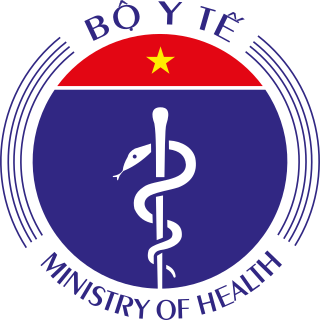
Việt Minh is the common and abbreviated name of the League for Independence of Vietnam, which was a communist-led national independence coalition formed at Pác Bó by Hồ Chí Minh on 19 May 1941. Also known as the Việt Minh Front, it was created by the Indochinese Communist Party (ICP) as a national united front to achieve the independence of the Democratic Republic of Vietnam.
"Tiến Quân Ca" is the national anthem of Vietnam. The march was written and composed by Văn Cao in 1944, and was adopted as the national anthem of North Vietnam in 1946 and subsequently the Socialist Republic of Vietnam in 1976 following the reunification of Vietnam. Though it has two verses, only the first one is usually sung.

Vietnam is divided into 63 first-level subdivisions, comprising fifty-eight provinces and five municipalities under the command of the central government. Municipalities are the highest-ranked cities in Vietnam. Municipalities are centrally-controlled cities and have special status equal to that of the provinces.

Brown rice is a whole grain rice with the inedible outer hull removed. This kind of rice sheds its outer hull or husk but the bran and germ layer remain on, constituting the brown or tan colour of rice. White rice is the same grain without the hull, the bran layer, and the cereal germ. Red rice, gold rice, and black rice are all whole rices with differently pigmented outer layers.

Ninh Bình is a province of Vietnam in the Red River Delta region of the northern part of the country. The province is famous for a high density of natural and cultural attractions, including reserved parks in Cúc Phương National Park and Vân Long, grotto caves and rivers in Tràng An, Tam Cốc-Bích Động and Múa Caves, historic monuments in the Hoa Lư ancient capital, Vietnam's largest buddhist worshiping complex, and the Phát Diệm Cathedral with "eclectic architectural style". Thanks to its adjacency to Hanoi, day trips from the capital are easily manageable.

Cam Ranh is a city in Southern Khánh Hòa Province, in the South Central Coast region of Vietnam.

The Ministry of Health is the government ministry responsible for the governance and guidance of the health, healthcare and health industry of Vietnam. In conjunction with other ministries and the prime minister's office, the Ministry is responsible for creating and promulgating long-term health policy programs such as the "National Strategy on Nutrition for the 2001 - 2010 period" and the "National Policy on Injury Prevention 2002 - 2010". Its main offices are located in Ba Đình District, Hanoi.

Trần Ngọc Lan Khuê is a Vietnamese model and beauty pageant titleholder. Lan Khuê rose to prominence in 2013 as she won the gold award in the Vietnam supermodel 2013, and became one of the most sought-after models in Vietnam. In 2014, she joined the Miss Aodai Vietnam pageant and won title. Then, she represented Vietnam in Miss World 2015 and was placed top 11. She shoot to fame when she got invited as one of 3 mentors in the reality show The Face Vietnam. Trần Ngọc Lan Khuê is the CEO of Elite Model Management and Elite Vietnam in Ho Chi Minh City.

The government of the Nguyễn dynasty, officially the Southern dynasty and commonly referred to as the Huế Court, centred around the emperor as the absolute monarch, surrounded by various imperial agencies and ministries which stayed under the emperor's presidency. Following the signing of the Patenôtre Treaty the French took over a lot of control and while the government of the Nguyễn dynasty still nominally ruled the French protectorates of Annam and Tonkin, in reality the French maintained control over these territories and the Nguyễn government became subsidiary to the administration of French Indochina. During World War II the Japanese launched a coup d'état ousting the French and establishing the Empire of Vietnam which was ruled by the Nguyễn government. During the August Revolution the Nguyễn government was abolished in the aftermath of World War II.
Here are the channel frequency table analog television broadcast/received in the provinces, the territory in Vietnam, divided by regions across the country. Currently, Analog TV nationwide has stopped broadcasting on 28 December 2020 due to government digitization roadmap. Previously, analog television in Vietnam mostly broadcast on the VHF band, and the UHF band, only a few places broadcast less than 6 VHF, like 3 VHF in Tam Dao).

Vietnam Post is the Vietnamese government-owned postal service.

Lê Anh Tú, commonly known by his dharma name Thích Minh Tuệ, is a Vietnamese Buddhist monk. After briefly practicing at a pagoda after giving up his job as a land surveyor, Thich Minh Tue decided to "learn and follow the Buddha's teachings" by observing the 13 ascetic practices of Theravada Buddhism and walking for alms across the country for many years. His 2024 walking journey attracted the attention of the Vietnamese public, attracting thousands of people to meet him and at times up to hundreds of people to follow him, leading to many social and security disturbances, and turning him into an "unwilling" Internet celebrity.
Mạnh Trường is a Vietnamese actor and model. He is known through the TV series Bí mật tam giác vàng , The Man Standing in the Wind , Zippo, Mustard and You , A Lifetime of Enmity , Against the Tide of Tears , Running Away from Youth , Live and Death , Love and Ambition , Crocodile Profile , Hương vị tình thân .










